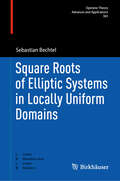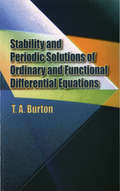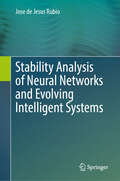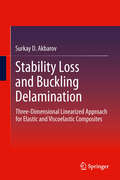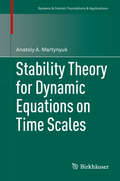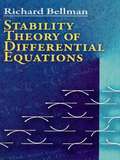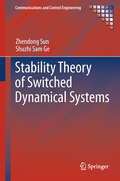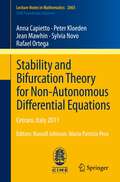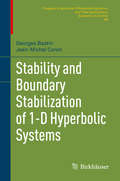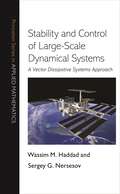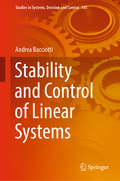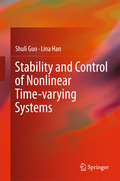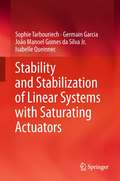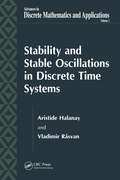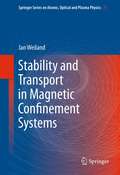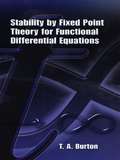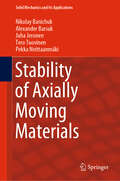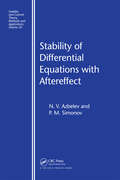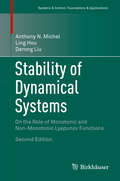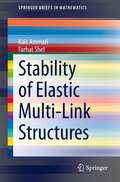- Table View
- List View
Square Roots of Elliptic Systems in Locally Uniform Domains (Operator Theory: Advances and Applications #303)
by Sebastian BechtelThis book establishes a comprehensive theory to treat square roots of elliptic systems incorporating mixed boundary conditions under minimal geometric assumptions. To lay the groundwork, the text begins by introducing the geometry of locally uniform domains and establishes theory for function spaces on locally uniform domains, including interpolation theory and extension operators. In these introductory parts, fundamental knowledge on function spaces, interpolation theory and geometric measure theory and fractional dimensions are recalled, making the main content of the book easier to comprehend. The centerpiece of the book is the solution to Kato's square root problem on locally uniform domains. The Kato result is complemented by corresponding Lp bounds in natural intervals of integrability parameters. This book will be useful to researchers in harmonic analysis, functional analysis and related areas.
Square Summable Power Series (Dover Books on Mathematics)
by James Rovnyak Louis De BrangesThis text for advanced undergraduate and graduate students introduces Hilbert space and analytic function theory, which is centered around the invariant subspace concept. The book's principal feature is the extensive use of formal power series methods to obtain and sometimes reformulate results of analytic function theory. The presentation is elementary in that it requires little previous knowledge of analysis, but it is designed to lead students to an advanced level of performance. This is achieved chiefly through the use of problems, many of which were proposed by former students. The book's tried-and-true approach was developed from the authors' lecture notes on courses taught at Lafayette College, Bryn Mawr College, and Purdue University.
Squares, Rectangles, and Other Quadrilaterals
by David A. AdlerGeometry is demystified in a new addition to a popular and amusing series of math picture books from a trusted team. Comical cats and dogs guide kids through the essential characteristics of squares, rectangles, parallelograms, rhomboids, and other quadrilaterals. Angles and degrees are explained in words and useful visuals. Kids will get a handle on geometric vocabulary and can try out plenty of hands-on activities that will help reinforce the concepts. A glossary is included.
Srinivasa Ramanujan: Life and Work of a Natural Mathematical Genius, Swayambhu
by K. Srinivasa RaoThis book offers a unique account on the life and works of Srinivasa Ramanujan—often hailed as the greatest “natural” mathematical genius. Sharing valuable insights into the many stages of Ramanujan’s life, this book provides glimpses into his prolific research on highly composite numbers, partitions, continued fractions, mock theta functions, arithmetic, and hypergeometric functions which led the author to discover a new summation theorem. It also includes the list of Ramanujan’s collected papers, letters and other material present at the Wren Library, Trinity College in Cambridge, UK. This book is a valuable resource for all readers interested in Ramanujan’s life, work and indelible contributions to mathematics.
St. Louis Cardinals: Where Have You Gone? Vince Coleman, Ernie Broglio, John Tudor, and Other Cardinals Greats (Where Have You Gone?)
by Rob Rains Keith SchildrothThe St. Louis Cardinals are a team steeped in history and a winning tradition. For proof look no further than the epic 2011 World Series! The secret to their success? It’s those special players who have been lucky enough to don the Birds at Bat. But whatever happened to those players once the bright stadium lights were dimmed and the cleats were hung up for good? St. Louis Cardinals: Where Have You Gone? provides the fascinating answer as the authors catch up with over thirty-five former Redbirds in this one-of-a-kind volume. Fans will delight in hearing about the post-baseball careers of stars from every era. Dick Groat shares his return to the sport closest to his heart: basketball; Bob Tewksbury hits the books and learns to write papers again as he completes his master’s degree in sport psychology; and Vince Coleman shares his playing skills with a new generation as a minor league coach and celebrity golfer. Life after baseball can be an unforeseen business venture, a few rounds of charity golf, 788 acres of seclusion, a minor league dugout, a PhD, or a blessing in disguise-whatever the outcome, it’s always an adventure any true Cardinals fan would love to share.
Stability & Periodic Solutions of Ordinary & Functional Differential Equations
by T. A. BurtonThis book's discussion of a broad class of differential equations will appeal to professionals as well as graduate students. Beginning with the structure of the solution space and the stability and periodic properties of linear ordinary and Volterra differential equations, the text proceeds to an extensive collection of applied problems. The background for and application to differential equations of the fixed-point theorems of Banach, Brouwer, Browder, Horn, Schauder, and Tychonov are examined, in addition to those of the asymptotic fixed-point theorems. The text concludes with a unified presentation of the basic stability and periodicity theory for nonlinear ordinary and functional differential equations.
Stability Analysis of Neural Networks and Evolving Intelligent Systems
by Jose de RubioThis book explores the stability analysis of neural networks and evolving intelligent systems, focusing on their ability to adapt to changing environments. It differentiates between neural networks, which have a static structure and dynamic parameter learning, and evolving intelligent systems, where both structure and parameters are dynamic. A key concern addressed is ensuring the stability of these systems, as instability can lead to damage or accidents in online applications. Stability Analysis of Neural Networks and Evolving Intelligent Systems emphasizes that stable algorithms used in these systems must be compact, effective, and stable. The book is divided into two parts: the first five chapters cover stability analysis of neural networks, while the latter five chapters explore stability analysis of evolving intelligent systems. The Lyapunov method is the primary tool used for these analyses. Neural networks are applied to various modeling and prediction tasks, including warehouse load distribution, wind turbine behavior, crude oil blending, and beetle population dynamics. Evolving intelligent systems are applied to modeling brain and eye signals, nonlinear systems with dead-zone input, and the Box Jenkins furnace. Each chapter introduces specific techniques and algorithms, such as a backpropagation algorithm with a time-varying rate for neural networks, analytic neural network models for wind turbines, and self-organizing fuzzy modified least square networks (SOFMLS) for evolving systems. The book also addresses challenges like incomplete data and big data learning, proposing hybrid methods and modified algorithms to improve performance and stability. The effectiveness of the proposed techniques is verified through simulations and comparisons with existing methods.
Stability Loss and Buckling Delamination
by Surkay AkbarovThis book investigates stability loss problems of the viscoelastic composite materials and structural members within the framework of the Three-Dimensional Linearized Theory of Stability (TDLTS). The stability loss problems are considered the development of the initial infinitesimal imperfection in the structure of the material or of the structural members. This development is studied within the framework of the Three-Dimensional Geometrical Non-Linear Theory of the Deformable Solid Body Mechanics. The solution to the corresponding boundary-value problems is presented in the series form in the small parameter which characterizes the degree of the initial imperfection. In this way, the nonlinear problems for the domains bounded by noncanonical surfaces are reduced for the same nonlinear problem for the corresponding domains bounded by canonical surfaces and the series subsequent linearized problems. It is proven that the equations and relations of these linearized problems coincide with the corresponding ones of the well-known TDLTS. Under concrete investigations as stability loss criterion the case is taken for the initial infinitesimal imperfection that starts to increase indefinitely. Moreover, it is proven that the critical parameters can be determined by the use of only the zeroth and first approximations.
Stability Theory for Dynamic Equations on Time Scales
by Anatoly A. MartynyukThis monograph is a first in the world to present three approaches for stability analysis of solutions of dynamic equations. The first approach is based on the application of dynamic integral inequalities and the fundamental matrix of solutions of linear approximation of dynamic equations. The second is based on the generalization of the direct Lyapunovs method for equations on time scales, using scalar, vector and matrix-valued auxiliary functions. The third approach is the application of auxiliary functions (scalar, vector, or matrix-valued ones) in combination with differential dynamic inequalities. This is an alternative comparison method, developed for time continuous and time discrete systems. In recent decades, automatic control theory in the study of air- and spacecraft dynamics and in other areas of modern applied mathematics has encountered problems in the analysis of the behavior of solutions of time continuous-discrete linear and/or nonlinear equations of perturbed motion. In the book "Men of Mathematics," 1937, E. T. Bell wrote: "A major task of mathematics today is to harmonize the continuous and the discrete, to include them in one comprehensive mathematics, and to eliminate obscurity from both. " Mathematical analysis on time scales accomplishes exactly this. This research has potential applications in such areas as theoretical and applied mechanics, neurodynamics, mathematical biology and finance among others.
Stability Theory of Differential Equations (Dover Books on Mathematics)
by Richard BellmanSuitable for advanced undergraduates and graduate students, this was the first English-language text to offer detailed coverage of boundedness, stability, and asymptotic behavior of linear and nonlinear differential equations. It remains a classic guide, featuring material from original research papers, including the author's own studies.The linear equation with constant and almost-constant coefficients receives in-depth attention that includes aspects of matrix theory. No previous acquaintance with the theory is necessary, since author Richard Bellman derives the results in matrix theory from the beginning. In regard to the stability of nonlinear systems, results of the linear theory are used to drive the results of Poincaré and Liapounoff. Professor Bellman then surveys important results concerning the boundedness, stability, and asymptotic behavior of second-order linear differential equations. The final chapters explore significant nonlinear differential equations whose solutions may be completely described in terms of asymptotic behavior. Only real solutions of real equations are considered, and the treatment emphasizes the behavior of these solutions as the independent variable increases without limit.
Stability Theory of Switched Dynamical Systems
by Zhendong Sun Shuzhi Sam GeThere are plenty of challenging and interesting problems open for investigation in the field of switched systems. Stability issues help to generate many complex nonlinear dynamic behaviors within switched systems. The authors present a thorough investigation of stability effects on three broad classes of switching mechanism: arbitrary switching where stability represents robustness to unpredictable and undesirable perturbation, constrained switching, including random (within a known stochastic distribution), dwell-time (with a known minimum duration for each subsystem) and autonomously-generated (with a pre-assigned mechanism) switching; and designed switching in which a measurable and freely-assigned switching mechanism contributes to stability by acting as a control input. For each of these classes this book propounds: detailed stability analysis and/or design, related robustness and performance issues, connections to other control problems and many motivating and illustrative examples.
Stability and Bifurcation Theory for Non-Autonomous Differential Equations
by Miguel Ortega Russell Johnson Sylvia Novo Anna Capietto Jean Mawhin Maria Patrizia Pera Peter KloedenThis volume contains the notes from five lecture courses devoted to nonautonomous differential systems, in which appropriate topological and dynamical techniques were described and applied to a variety of problems. The courses took place during the C.I.M.E. Session "Stability and Bifurcation Problems for Non-Autonomous Differential Equations," held in Cetraro, Italy, June 19-25 2011. Anna Capietto and Jean Mawhin lectured on nonlinear boundary value problems; they applied the Maslov index and degree-theoretic methods in this context. Rafael Ortega discussed the theory of twist maps with nonperiodic phase and presented applications. Peter Kloeden and Sylvia Novo showed how dynamical methods can be used to study the stability/bifurcation properties of bounded solutions and of attracting sets for nonautonomous differential and functional-differential equations. The volume will be of interest to all researchers working in these and related fields.
Stability and Boundary Stabilization of 1-D Hyperbolic Systems
by Jean-Michel Coron Georges BastinThis monograph explores the modeling of conservation and balance laws of one-dimensional hyperbolic systems using partial differential equations. It presents typical examples of hyperbolic systems for a wide range of physical engineering applications, allowing readers to understand the concepts in whichever setting is most familiar to them. With these examples, it also illustrates how control boundary conditions may be defined for the most commonly used control devices. The authors begin with the simple case of systems of two linear conservation laws and then consider the stability of systems under more general boundary conditions that may be differential, nonlinear, or switching. They then extend their discussion to the case of nonlinear conservation laws and demonstrate the use of Lyapunov functions in this type of analysis. Systems of balance laws are considered next, starting with the linear variety before they move on to more general cases of nonlinear ones. They go on to show how the problem of boundary stabilization of systems of two balance laws by both full-state and dynamic output feedback in observer-controller form is solved by using a "backstepping" method, in which the gains of the feedback laws are solutions of an associated system of linear hyperbolic PDEs. The final chapter presents a case study on the control of navigable rivers to emphasize the main technological features that may occur in real live applications of boundary feedback control. Stability and Boundary Stabilization of 1-D Hyperbolic Systems will be of interest to graduate students and researchers in applied mathematics and control engineering. The wide range of applications it discusses will help it to have as broad an appeal within these groups as possible.
Stability and Control of Large-Scale Dynamical Systems: A Vector Dissipative Systems Approach (Princeton Series in Applied Mathematics #41)
by Sergey G. Nersesov Wassim M. HaddadModern complex large-scale dynamical systems exist in virtually every aspect of science and engineering, and are associated with a wide variety of physical, technological, environmental, and social phenomena, including aerospace, power, communications, and network systems, to name just a few. This book develops a general stability analysis and control design framework for nonlinear large-scale interconnected dynamical systems, and presents the most complete treatment on vector Lyapunov function methods, vector dissipativity theory, and decentralized control architectures. Large-scale dynamical systems are strongly interconnected and consist of interacting subsystems exchanging matter, energy, or information with the environment. The sheer size, or dimensionality, of these systems necessitates decentralized analysis and control system synthesis methods for their analysis and design. Written in a theorem-proof format with examples to illustrate new concepts, this book addresses continuous-time, discrete-time, and hybrid large-scale systems. It develops finite-time stability and finite-time decentralized stabilization, thermodynamic modeling, maximum entropy control, and energy-based decentralized control. This book will interest applied mathematicians, dynamical systems theorists, control theorists, and engineers, and anyone seeking a fundamental and comprehensive understanding of large-scale interconnected dynamical systems and control.
Stability and Control of Linear Systems (Studies in Systems, Decision and Control #185)
by Andrea BacciottiThis advanced textbook introduces the main concepts and advances in systems and control theory, and highlights the importance of geometric ideas in the context of possible extensions to the more recent developments in nonlinear systems theory. Although inspired by engineering applications, the content is presented within a strong theoretical framework and with a solid mathematical background, and the reference models are always finite dimensional, time-invariant multivariable linear systems. The book focuses on the time domain approach, but also considers the frequency domain approach, discussing the relationship between the two approaches, especially for single-input-single-output systems. It includes topics not usually addressed in similar books, such as a comparison between the frequency domain and the time domain approaches, bounded input bounded output stability (including a characterization in terms of canonical decomposition), and static output feedback stabilization for which a simple and original criterion in terms of generalized inverse matrices is proposed. The book is an ideal learning resource for graduate students of control theory and automatic control courses in engineering and mathematics, as well as a reference or self-study guide for engineers and applied mathematicians.
Stability and Control of Nonlinear Time-varying Systems
by Shuli Guo Lina HanThis book presents special systems derived from industrial models, including the complex saturation nonlinear functions and the delay nonlinear functions. It also presents typical methods, such as the classical Liapunov and Integral Inequalities methods. Providing constructive qualitative and stability conditions for linear systems with saturated inputs in both global and local contexts, it offers practitioners more concise model systems for modern saturation nonlinear techniques, which have the potential for future applications. This book is a valuable guide for researchers and graduate students in the fields of mathematics, control, and engineering.
Stability and Stabilization of Linear Systems with Saturating Actuators
by João Manoel Gomes Da Silva Jr. Germain Garcia Isabelle Queinnec Sophie TarbouriechThis monograph details basic concepts and tools fundamental for the analysis and synthesis of linear systems subject to actuator saturation and developments in recent research. The authors use a state-space approach and focus on stability analysis and the synthesis of stabilizing control laws in both local and global contexts. Different methods of modeling the saturation and behavior of the nonlinear closed-loop system are given special attention. Various kinds of Lyapunov functions are considered to present different stability conditions. Results arising from uncertain systems and treating performance in the presence of saturation are given. The text proposes methods and algorithms, based on the use of linear programming and linear matrix inequalities, for computing estimates of the basin of attraction and for designing control systems accounting for the control bounds and the possibility of saturation. They can be easily implemented with mathematical software packages.
Stability and Stable Oscillations in Discrete Time Systems
by Aristide Halanay Vladimir RasvanThe expertise of a professional mathmatician and a theoretical engineer provides a fresh perspective of stability and stable oscillations. The current state of affairs in stability theory, absolute stability of control systems, and stable oscillations of both periodic and almost periodic discrete systems is presented, including many applications in
Stability and Transport in Magnetic Confinement Systems
by Jan WeilandStability and Transport in Magnetic Confinement Systems provides an advanced introduction to the fields of stability and transport in tokamaks. It serves as a reference for researchers with its highly-detailed theoretical background, and contains new results in the areas of analytical nonlinear theory of transport using kinetic theory and fluid closure. The use of fluid descriptions for advanced stability and transport problems provide the reader with a better understanding of this topic. In addition, the areas of nonlinear kinetic theory and fluid closure gives the researcher the basic knowledge of a highly relevant area to the present development of transport physics.
Stability by Fixed Point Theory for Functional Differential Equations
by T. A. BurtonThis book is the first general introduction to stability of ordinary and functional differential equations by means of fixed point techniques. It contains an extensive collection of new and classical examples worked in detail and presented in an elementary manner. Most of this text relies on three principles: a complete metric space, the contraction mapping principle, and an elementary variation of parameters formula. The material is highly accessible to upper-level undergraduate students in the mathematical sciences, as well as working biologists, chemists, economists, engineers, mathematicians, physicists, and other scientists using differential equations. It also introduces many research problems that promise to remain of ongoing interest.
Stability of Axially Moving Materials (Solid Mechanics and Its Applications #259)
by Pekka Neittaanmäki Nikolay Banichuk Juha Jeronen Tero Tuovinen Alexander BarsukThis book discusses the stability of axially moving materials, which are encountered in process industry applications such as papermaking. A special emphasis is given to analytical and semianalytical approaches. As preliminaries, we consider a variety of problems across mechanics involving bifurcations, allowing to introduce the techniques in a simplified setting. In the main part of the book, the fundamentals of the theory of axially moving materials are presented in a systematic manner, including both elastic and viscoelastic material models, and the connection between the beam and panel models. The issues that arise in formulating boundary conditions specifically for axially moving materials are discussed. Some problems involving axially moving isotropic and orthotropic elastic plates are analyzed. Analytical free-vibration solutions for axially moving strings with and without damping are derived. A simple model for fluid--structure interaction of an axially moving panel is presented in detail. This book is addressed to researchers, industrial specialists and students in the fields of theoretical and applied mechanics, and of applied and computational mathematics.
Stability of Differential Equations with Aftereffect (Stability and Control: Theory, Methods and Applications)
by N.V. Azbelev P.M. SimonovStability of Differential Equations with Aftereffect presents stability theory for differential equations concentrating on functional differential equations with delay, integro-differential equations, and related topics. The authors provide background material on the modern theory of functional differential equations and introduce some new flexible
Stability of Dynamical Systems
by Anthony N. Michel Derong Liu Ling HouThe second edition of this textbook provides a single source for the analysis of system models represented by continuous-time and discrete-time, finite-dimensional and infinite-dimensional, and continuous and discontinuous dynamical systems. For these system models, it presents results which comprise the classical Lyapunov stability theory involving monotonic Lyapunov functions, as well as corresponding contemporary stability results involving non-monotonic Lyapunov functions. Specific examples from several diverse areas are given to demonstrate the applicability of the developed theory to many important classes of systems, including digital control systems, nonlinear regulator systems, pulse-width-modulated feedback control systems, and artificial neural networks. The authors cover the following four general topics: - Representation and modeling of dynamical systems of the types described above - Presentation of Lyapunov and Lagrange stability theory for dynamical systems defined on general metric spaces involving monotonic and non-monotonic Lyapunov functions - Specialization of this stability theory to finite-dimensional dynamical systems - Specialization of this stability theory to infinite-dimensional dynamical systems Replete with examples and requiring only a basic knowledge of linear algebra, analysis, and differential equations, this book can be used as a textbook for graduate courses in stability theory of dynamical systems. It may also serve as a self-study reference for graduate students, researchers, and practitioners in applied mathematics, engineering, computer science, economics, and the physical and life sciences. Review of the First Edition: "The authors have done an excellent job maintaining the rigor of the presentation, and in providing standalone statements for diverse types of systems. [This] is a very interesting book which complements the existing literature. [It] is clearly written, and difficult concepts are illustrated by means of good examples. " - Alessandro Astolfi, IEEE Control Systems Magazine, February 2009
Stability of Elastic Multi-Link Structures (SpringerBriefs in Mathematics)
by Kaïs Ammari Farhat ShelThis brief investigates the asymptotic behavior of some PDEs on networks. The structures considered consist of finitely interconnected flexible elements such as strings and beams (or combinations thereof), distributed along a planar network. Such study is motivated by the need for engineers to eliminate vibrations in some dynamical structures consisting of elastic bodies, coupled in the form of chain or graph such as pipelines and bridges. There are other complicated examples in the automotive industry, aircraft and space vehicles, containing rather than strings and beams, plates and shells. These multi-body structures are often complicated, and the mathematical models describing their evolution are quite complex. For the sake of simplicity, this volume considers only 1-d networks.
Stability of Functional Equations in Banach Algebras
by Reza Saadati Yeol Je Cho Themistocles M. Rassias Choonkil ParkSome of the most recent and significant results on homomorphisms and derivations in Banach algebras, quasi-Banach algebras, C*-algebras, C*-ternary algebras, non-Archimedean Banach algebras and multi-normed algebras are presented in this book. A brief introduction for functional equations and their stability is provided with historical remarks. Since the homomorphisms and derivations in Banach algebras are additive and R-linear or C-linear, the stability problems for additive functional equations and additive mappings are studied in detail. The latest results are discussed and examined in stability theory for new functional equations and functional inequalities in Banach algebras and C*-algebras, non-Archimedean Banach algebras, non-Archimedean C*-algebras, multi-Banach algebras and multi-C*-algebras. Graduate students with an understanding of operator theory, functional analysis, functional equations and analytic inequalities will find this book useful for furthering their understanding and discovering the latest results in mathematical analysis. Moreover, research mathematicians, physicists and engineers will benefit from the variety of old and new results, as well as theories and methods presented in this book.
